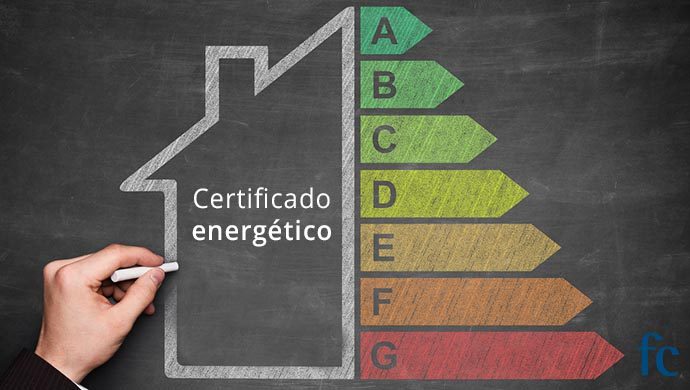
What is the Energy Efficiency Certificate and what does it affect?
The certification of the energy efficiency of buildings is a recognizable and objective mark on the energy efficiency characteristics of a building. This materializes in the form of a certificate or label that allows buyers, tenants and other users to assess and compare its benefits.
Energy efficiency has two well-differentiated aspects, active and passive efficiency.
Active efficiency is the one that consists of improving the building’s installations with the use of different alternative energies or combined with traditional energies and also with new generation systems that improve performance and minimize consumption.
Passive efficiency refers to the conditions and architectural characteristics of the building in which the energies are introduced to obtain the degree of comfort.
Passive efficiency is guaranteed with the use of the CTE (Technical Building Code) in newly built homes, while in existing ones it is necessary to find a balance between active and passive efficiency, a fundamental aspect to reach reasonable energy consumption. .
A clear example of all of the above is the current Passive Haus that emerged in Germany, which combines them perfectly.
In short, the energy efficiency certificate is the document signed by a certifying technician that contains information on the energy characteristics and energy efficiency of a building or its unit, calculated in accordance with the calculation methodology defined by the Ministries of Industry, Energy and Tourism and Development.
The certificate measures the energy efficiency of the building taking into account the energy consumption, calculated or measured, that is estimated to be necessary to satisfy the energy demand of the building under normal conditions of operation and occupation, which includes the energy consumed in:
Heating-Cooling-Ventilation-Production of domestic hot water (DHW)-Lighting
Normative.
Main article: Directive on energy efficiency in buildings.
History
The requirements relating to the energy certification of buildings established in Directive 2002/91/EC of the European Parliament and of the Council, of December 16, 2002, were transposed into Royal Decree 47/2007, of January 19, by which A basic procedure for the energy efficiency certification of newly built buildings was approved, pending regulation, by means of another complementary provision, the energy certification of existing buildings.
Royal Decree 235/2013
Directive 2002/91/EC of the European Parliament and of the Council, of December 16, 2002, has been modified by Directive 2010/31/EU of the European Parliament and of the Council, of May 19, 2010, regarding the efficiency of buildings, a circumstance that makes it necessary to transpose back into the Spanish legal system the modifications that it introduces with respect to the amended Directive.
Although this transposition could be carried out by means of a new provision that modifies Royal Decree 47/2007, of January 19, and which at the same time completes the transposition contemplating the existing buildings, it seems pertinent that, for administrative economy, it be carried out by means of a single provision that recasts what is valid in the 2007 standard, repeals and completes it, incorporating the innovations incorporated in the new directive and extending its scope to all buildings, including existing ones.
Consequently, through Royal Decree 235/2013, of April 5, which approves the basic procedure for the certification of the energy efficiency of buildings, partially transposes Directive 2010/31/EU of the European Parliament and of the Council, of May 19, 2010, in relation to the certification of energy efficiency of buildings, consolidating Royal Decree 47/2007, of January 19, with the incorporation of the Basic Procedure for the certification of energy efficiency of existing buildings, also taking into consideration the experience of its application in the last five years.
Calculation methods.
The official reference computer program whose correct application is sufficient to certify compliance with the officially established requirements is called Calener.
Certificate content.
The energy efficiency certificate of the building or building unit must contain at least the following information:
Identification of the building or unit of the building that is certified, including cadastral reference.
Indication of the recognized procedure used to obtain the energy efficiency rating.
Indication of the regulations on energy saving and efficiency that were applicable at the time of construction, in the case of existing buildings.
Description of the building’s energy characteristics, thermal envelope, facilities, normal operating and occupancy conditions, thermal and lighting comfort conditions, indoor air quality and other data used to obtain the building’s energy efficiency rating.
Rating of energy efficiency of the building expressed through the energy label.
Document of recommendations for the improvement of the optimal or profitable levels of energy performance of a building or a unit of it, unless there is no reasonable potential for such an improvement compared to current energy performance requirements.
The recommendations included in the energy performance certificate will address:
the measures applied in the framework of major reforms of the envelope or the technical installations of a building.
the measures related to elements of a building, regardless of the realization of important reforms of the envelope or of the technical installations of a building.
The recommendations included in the energy efficiency certificate will be technically feasible in the specific building and may include an estimate of the investment recovery periods or profitability during its useful life cycle.
It will contain information for the owner or tenant on where to obtain more detailed information, including information on the cost-effectiveness of the recommendations made in the certificate. The evaluation of this relationship will be made on the basis of a series of standard criteria, such as the evaluation of energy savings, underlying energy prices and a preliminary cost forecast.
It will report on the actions to be undertaken to put the recommendations into practice. You can provide the owner or tenant with information on other related topics, such as energy audits or incentives of a financial or other nature and the possibility of financing.
Description of the tests, verifications and inspections carried out, by the certifying technician, during the energy qualification phase in order to establish the conformity of the information contained in the energy performance certificate with the building.


